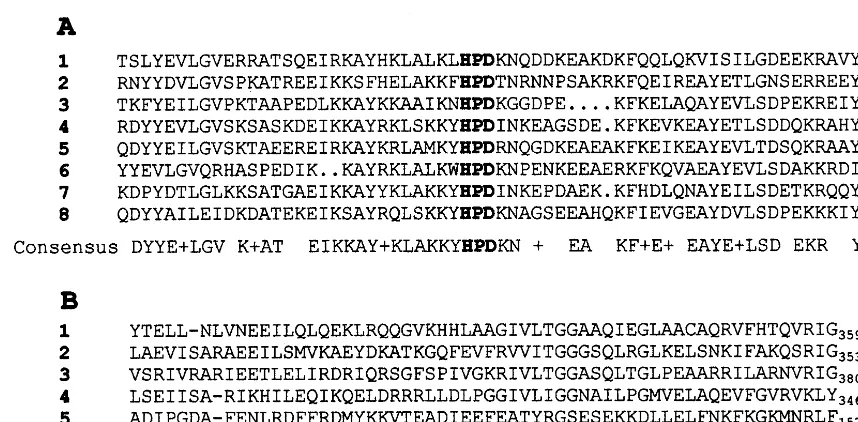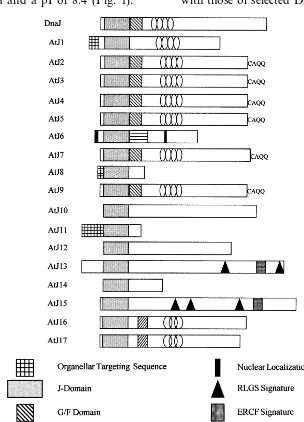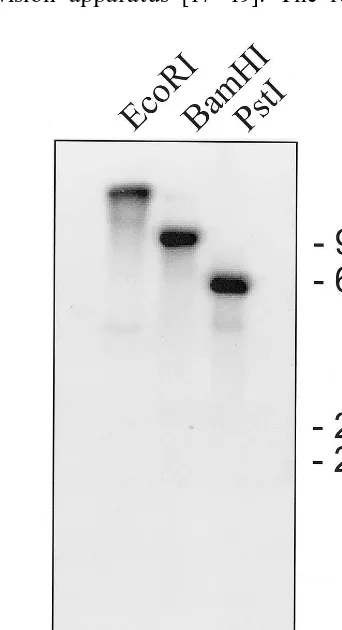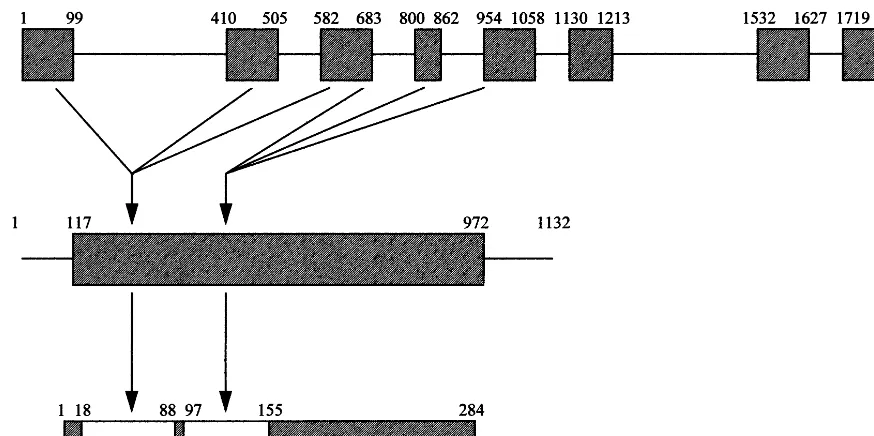AtJ6, a unique J-domain protein from
Arabidopsis thaliana
Barbara Kroczyn´ska
1, Nichole E. Coop, Jan A. Miernyk *
Mycotoxin Research Unit,USDA,Agricultural Research Ser6ice,National Center for Agricultural Utilization Research,1815N.Uni6ersity St.,
Peoria,IL61604-3902,USA
Received 3 June 1999; received in revised form 3 September 1999; accepted 15 September 1999
Abstract
AnArabidopsis thaliana cDNA encoding a protein, AtJ6, related toEscherichia coliDnaJ was sequenced. Translation of the AtJ6 nucleotide sequence yields a protein with an N-terminal J-domain, but which lacks the G/F, and C-rich domains characteristic of DnaJ. In addition to the J-domain, one region of the sequence has homology with the prokaryotic FtsA protein. The remainder of the AtJ6 sequence is not notably related to anything in the sequence databases. The AtJ6 sequence represents a unique member of theA.thalianaJ-domain protein family. The results of Northern analysis revealed that the AtJ6 mRNA is expressed in all organs of A. thaliana; expression was high in leaves, flowers, and siliques, and low in roots. The results of Southern analysis are consistent with a single unique gene. © 2000 Elsevier Science Ireland Ltd. All rights reserved.
Keywords:cDNA; Chaperone; Exon; Expression; Gene; Intron; Nucleotide sequence
www.elsevier.com/locate/plantsci
1. Introduction
The 70 kD stress proteins comprise a ubiquitous set of highly conserved molecular chaperones [1,2]. The Stress70 proteins do not, however, function as chaperones by themselves but rather in concert with two accessory or co-chaperone proteins. The functional association of these components is of-ten referred to as the Stress70 chaperone ‘machine’ [2,3]. The archetypical Stress70 chaperone machine
was defined in Escherichia coli, and consists of the
products of dnaK (Stress70), dnaJ and grpE.
DnaK is the central, ATP-dependent component of the machine, and functions as a chaperone in
association with DnaJ, an activating protein, and GrpE, a nucleotide exchange factor [4,5].
DnaJ was first isolated as a 41 kDa heat shock
protein from E. coli [6]. It was subsequently
re-ported that DnaJ was involved with DNA replica-tion, stimulating the capacity of DnaK to form a replication-competent complex at the phage origin of replication. It has been demonstrated that DnaJ stimulates the rate of hydrolysis of DnaK-bound ATP [4]. This stimulation by DnaJ is similar in concept to the effect of the GTPase activating proteins upon the low molecular weight GTP-binding proteins [7]. In addition to co-operating with DnaK, it has been demonstrated that DnaJ can function independently as a chaperone [3].
It was subsequently shown that homologues of DnaJ are present in all of the compartments of eukaryotic cells [8]. The eukaryotic DnaJ homo-logues also function as co-chaperones in conjunc-tion with DnaK homologues (70 kD stress proteins). Furthermore, roles for DnaJ homo-logues in signal transduction [9] and controlled proteolysis [10] have been described. Flowering plant cells are particularly rich in DnaJ homo-Abbre6iations:Stress70, any of the 70 kDa family of stress related
proteins.
The GenBank accession number for the sequences reported in this article is AF037168.
* Corresponding author. Present address: USDA, ARS, Plant Ge-netics Research Unit, Curtis Hall, University of Missouri, Columbia, MO 65211, USA. Tel.: +1-573-8828167; fax:+1-573-884-7850.
E-mail address:[email protected] (J.A. Miernyk)
1Permanent address: Institute of Biochemistry and Biophysics, Polish Academy of Sciences, Pawin´skiego 5A, 02-106 Warszawa, Poland.
B.Kroczyn´ska et al./Plant Science69 – 70 (2000) 19 – 27 20
logues, perhaps in part due to the extensive com-partmentation. We are in the process of cloning and characterizing cDNAs for all of the DnaJ
homologues from the model plant Arabidopsis
thaliana [11 – 13]. Herein we report the sequence of a cDNA encoding a unique J-domain protein, AtJ6.
2. Materials and methods
2.1. Reagents
Unless otherwise noted, DNA modifying en-zymes were from New England BioLabs (Beverly, MA) and were used according to the manufactur-ers recommendations. All buffmanufactur-ers were from Re-search Organics, Inc. (Cleveland, OH). Other biochemicals were from the Sigma Chemical Com-pany (St. Louis, MO) and were of the highest purity available.
2.2. Biological materials
An Arasystems kit, and seeds of A. thaliana
WT-2 var. Columbia were from Lehle Seeds (Round Rock, TX). Seeds were germinated ac-cording to the supplier’s suggestions. Seedlings were grown in a Percival (Boone, IA) growth chamber at 23°C and a 14 h photoperiod of 200
mE/m2 per s photosynthetically active radiation.
2.3. Nucleic acids
An EST clone, ID 161j18t7, was obtained from the Arabidopsis Biological Resource Center, The Ohio State University. This clone is a random
SalI×NotI fragment inserted into pZL1. An A.
thaliana cDNA library (leaves of 4.5 week,
light-grown plants, var. Columbia) in lgt11 was from
Clontech (Palo Alto, CA). Oligonucleotides were prepared using an Applied Biosystems Model 381a
Fig. 2. AtJ6 sequence comparisons. (A) Alignment of the AtJ6 J-domain with those ofE.coliDnaJ and selected homologues. The sequences compared are: (1) AtJ6 (GenBank accession AF037168); (2)A.thalianaAtJ1 (U16246); (3)A.thalianaAtJ2 (L36113); (4)E.coliDnaJ (M12565); (5)Homo sapiensHDJ2 (AF080569); (6)Saccharomyces cere6isiaeMDJ1p (Z28336); (7)S.cere6isiae
SCJ1p (X58679); (8)Bacillus subtilisDnaJ (M84964). If at least four of the eight sequences are identical, this is the consensus. If at least four residues are similar, this is indicated by (+). The HPDb-turn motif is presented in bold typeface. (B) Alignment of the regions of sequence homology between AtJ6 and bacterial FtsA proteins. Sequences compared are: (1) E.coli (K02668);
Rickettsia prowazekii(AJ235271); (3) Sinorhizobium meliloti(AF024660); (4)Streptococcus pneumoniae (AF068910); (5) AtJ6. If at least three of the sequences are identical, this is the consensus. If at least three residues are similar, this is indicated by (+). Spaces (.) have been inserted to optimize homology. Clustal alignments were performed using the DNAMAN sequence analysis program, version 2.71.
synthesizer using the phosphoramidite, trityl-off program, then purified by precipitation.
2.4. DNA sequencing
Sequencing was performed using an Applied
Biosystems Taq DyeDeoxy Terminator Cycle
Se-quencing kit and a Model 370A Applied Biosys-tems Automated DNA Sequencer. The sequences of internal primers were based upon 3’-proximal
regions of previously determined sequences.
These 20-mer sequencing primers were prepared using the Applied Biosystems Synthesizer. DNA sequence analysis and manipulation, and com-parison with published sequences, were accom-plished using the program DNAMAN, version 2.71, from Lynnon BioSoft, Vaudreui, Quebec, Canada.
2.5. Northern and southern analyses
Total RNA was isolated from various organs
of A. thaliana using the materials and protocol supplied by Clontech Laboratories (Palo Alto, CA) with the Extract-A-Plant RNA isolation kit.
Poly A+RNA was separated from total RNA
using the mRNA Separator kit from Clontech. Electrophoresis of RNA through formaldehyde-containing gels, transfer to Amersham Hybond N nylon membranes, and hybridization with DNA probes were as previously described [11].
Ge-nomic DNA was isolated from A. thaliana leaves,
restriction digested, separated by agarose gel elec-trophoresis, and transferred to nylon membranes as previously described [11]. The complete AtJ6 cDNA was used as a probe, and was labeled
with [32P]dCTP using the Random Primer DNA
Labeling Kit from Bio-Rad Laboratories (Rich-mond, CA). This same probe was used to detect RNA on Northern blots and DNA on Southern
blots. Images from gels/films/membranes were
B.Kroczyn´ska et al./Plant Science69 – 70 (2000) 19 – 27 22
3. Results and discussion
3.1. Characteristics of the nucleotide and deduced amino acid sequences
The 1132 bp cDNA was sequenced completely in both directions (Fig. 1). The clone comprises
117 bp of 5%-UTR, an 852 bp reading frame, and
163 bp of 3%-UTR. The 3%-UTR ends in a 23 base
poly-A tail. The cDNA reading frame encodes a polypeptide of 284 amino acids with a molecular weight of 32 603 Da and a pI of 8.4 (Fig. 1).
3.2. Homology with DnaJ
Amino acids 19 through 91 of AtJ6 define the J-domain, a region thought to have a direct physi-cal interaction with the Stress70 component of the
chaperone machine [2,14,15]. The HPD b-turn
motif, that is both diagnostic of and absolutely essential for DnaJ function, is present in the same relative position within the AtJ6 sequence as is found in DnaJ and most eukaryotic homologues (Fig. 1). The AtJ6 J-domain sequence was aligned with those of selected DnaJ homologues (Fig. 2A),
Fig. 4. Expression of the AtJ6 mRNA. Messenger RNAs, isolated from total RNA fractions of leaves (lane 1), roots (2), flowers (3) and siliques (4), were separated on formaldehyde-containing agarose gels, then hybridized with the32P-labeled
cDNA. The carat to the right of lane 4 indicates the position of the 1.2 kb AtJ6 mRNA.
3.3. A region of homology with FtsA
The sequence of AtJ6 less the J-domain was analyzed for clues to cellular function. Several computer algorithms were employed in order to search for sequence motifs involved in protein
interactions (i.e., http://apbiotech.com/protein/
protint), but none were detected. Homology with other proteins was searched using the various BLAST (Basic Local Alignment Search Tool) al-gorithms available from the National Center for
Biotechnology Information (http://www.ncbi.
nlm.nih.gov/). The AtJ6 sequence less the
J-do-main has limited homology with other sequences in the various computer databases. The BLAST searches did, however, identify one region of the AtJ6 sequence that has homology with the prokaryotic cell division protein FtsA (Fig. 2B). The Fts proteins are components of the cell division apparatus [17 – 19]. The region of FtsA
Fig. 5. Southern analysis of AtJ6. Genomic DNA was iso-lated from light-grown A. thaliana seedlings. Ten mg each were digested with EcoRI (lane 1), BamHI (lane 2) or PstI (lane 3), transferred to a positively-charged Nylon membrane, and then hybridized with the 32P-labeled cDNA. The
posi-tions of size markers are indicated to the right of lane 3.
revealing the high degree of sequence conservation that is typical of this class of proteins. This com-parison includes sequences from bacteria, yeast, plants and animals, as well as cytoplasmic, mito-chondrial, and endoplasmic reticulum-resident proteins.
The G/F domain of DnaJ and homologues is
simply a region of approximately 50 amino acid residues immediately downstream of the J-domain
that is rich in Gly and Phe residues [14]. E. coli
DnaJ has 21/50 Gly plus Phe residues, while theA.
thaliana homologue AtJ2 has 18/50 [12]. It has
been proposed that the G/F-domain might serve
to regulate target polypeptide specificity, and to modify ATPase activity and chaperone function
[16]. The AtJ6 sequence (Fig. 1) has only 5/50 Gly
B.Kroczyn´ska et al./Plant Science69 – 70 (2000) 19 – 27 24
Fig. 6. Schematic representations of the AtJ6 gene, cDNA and protein structures. Exons are presented as cross-hatched boxes, while introns are horizontal lines. The location, in bp, of exons and introns is indicated above the gene or cDNA structure. The location of amino acid residues corresponding to protein sequence domains is indicated above the cross-hatched box. The relative positions of the J-domain and the region of FtsA homology in the gene, cDNA and protein are indicated by the arrows.
homology in AtJ6 is part of the ATP-binding site [18,19]. The greatest sequence conservation be-tween FtsA and AtJ6 in this region has been identified in the former as the site of adenosine binding. Other portions of FtsA that are in con-tact with ATP are single or paired residues that lack highly conserved flanking sequences. While none of these residues are in an identical position in AtJ6, this could be a function of differences in protein secondary structure. FtsA is phosphory-lated, possibly via autophosphorylation [20]. AtJ6
has a Thr residue (Thr131) in the same relative
position as the Thr phosphorylated in E. coli
FtsA, although again the lack of conserved flank-ing sequences raises the possibility of coincidence. Phosphorylated FtsA is a cytoplasmic ATP-bind-ing protein. When dephosphorylated, the protein is membrane associated and cannot bind ATP [20]. Tests of ATP binding and phosphorylation await expression of the recombinant protein and prepa-ration of suitable antibodies.
3.4. The A. thaliana family of J-domain proteins
The only well understood roles for DnaJ and DnaJ homologues are as molecular chaperones or co-chaperones [7]. In this context, the
participa-tion of the J-, G/F- and zinc finger-domains have
been characterized [14]. Increasingly, whole
genome sequencing projects are generating data suggesting J-domain proteins that lack some or all of the other functional domains. A terminology for J-domain proteins has been recently proposed [14]. In this system, type I homologues have all three of the characteristic DnaJ domains, type II
homologues have the J-plus G/F- or zinc finger
domains, and type III homologues have only the J-domain. AtJ6 is a type III homologue. The only defined function for the J-domain is in directing interactions with the Stress70 and target polypep-tide components of the chaperone machine [15].
A schematic display of theA. thaliana J-domain
family of proteins described to date is presented in Fig. 3. AtJ2 [12] and AtJ3 [13] are type I J-domain proteins that partition between the cytoplasm and the outer surface of organellar membranes [21,22].
AtJ4/5/7/9 are very similar in sequence and
orga-nization to AtJ2/3 (J.A.M., unpublished). AtJ1
[11] is a type II J-domain protein and is located within the mitochondrial matrix. AtJ6 has a
J-do-main but lacks the G/F- and zinc finger domains
(Figs. 1 and 2A) and is thus a type III protein [14]. AtJ6 has a region of FtsA homology (Fig. 2B)
where type I proteins have the G/F-domain (Fig.
3).
AtJ8/11/14 are very small type III J-domain
and AtJ11 [23], both of which are plastid-local-ized, the J-domain is preceded by a transit peptide. The AtJ14 sequence contains no obvious subcellu-lar localization information.
AtJ10 [24] is a large type III J-domain protein
related to S. cere6isiae CAJ1p [25]. While it was
suggested that AtJ10 is a potential CaM-binding protein, the sequence does not contain any obvi-ous CaM-binding motifs. CAJ1p binds CaM indi-rectly via its interaction with the bona fide CaM-binding protein Stress70 [25]. AtJ12,
se-quenced as part of theA. thaliana genome project,
is another large type III J-domain protein related to CAJ1p (Fig. 3).
AtJ13/15/16/17 are also large type III J-domain
proteins (Fig. 3). AtJ15 was isolated using a yeast genetic screen for proteins that aid tolerance of oxidative stress [26]. The mechanism for this activ-ity is unknown. In addition to the J-domain, the AtJ15 sequence contains rhodopsin-like GPCR su-perfamily and erythrocruorin family signature se-quences (Fig. 3). AtJ13, sequenced as part of the genome initiative, is an AtJ15 isologue. AtJ16 was isolated as Altered Response to Gravity 1 (ARG1) [27]. It has a potential transmembrane sequence followed by a coiled-coil domain. The latter is thought to mediate protein:protein interactions. AtJ17, also sequenced as part of the genome initia-tive, is an AtJ16 isologue.
The A. thaliana J-proteins comprise a large and more diverse family than has been reported from any other organism [8,14], and many of the AtJ proteins are type III homologues. However, even among this group, AtJ6 is unique in having a specific region with high homology to the FtsA cell division-protein (Fig. 2B,Fig. 3). The only known role for protein J-domains is interaction with the Stress70 chaperone machine [7,14,15]. Identification and characterization of proteins that
specifically interact with the diverse A. thaliana
J-domain proteins pose a formidable challenge for plant cell biologists.
3.5. Subcellular localization
The subcellular localization of the AtJ6 protein
was examined using the PSORT program (http://
www.imcb.osaka-u.ac.jp/nakai/psort.html),
ver-sion 6.4. This analysis predicts a \93%
probability that AtJ6 is nuclear localized. There are two prominent polybasic motifs in the AtJ6
sequence that could serve as nuclear localization
signals [28]; RKKK6and RKRKKKK215(Fig. 1).
It was recently proposed that the J-domain serves to recruit the Stress70 chaperone machine to spe-cific subcellular locations [29]. In this context, one can envision AtJ6 serving as a locus for docking of the remainder of the chaperone machine in the nucleus. The possibility of a nuclear location of AtJ6 makes the potential role for the FtsA-like domain all the more intriguing.
3.6. Expression
DnaJ is a heat shock protein; it is expressed at low level during normal growth but then greatly induced upon heat stress [5]. Many eukaryotic DnaJ homologues are constitutively expressed, and there is less than a 10-fold increase in response to thermal stress [7]. Messenger RNA was sepa-rated from the total RNA isolated from various
organs of light-grownA.thaliana. The mRNA was
separated by agarose gel electrophoresis, then
hy-bridized with the 32P-labeled cDNA. A single 1.2
kb band was observed (Fig. 4). The AtJ6 mRNA was expressed in all organs, although the level in roots was relatively low. Northern analysis of plants exposed to a moderate heat shock (1 h at 37°C) showed no significant difference from con-trol plants (data not presented).
3.7. The AtJ6 gene
Single bands were observed when A. thaliana
genomic DNA was cut with the restriction
en-zymes EcoRI, BamHI orPstI and then hybridized
with 32P-labeled AtJ6 (Fig. 5). These results are
consistent with AtJ6 being encoded by a single unique structural gene.
While this manuscript was in preparation, a genomic sequence likely corresponding to AtJ6
became available as part of theA.thaliana genome
project (GenBank Accession AB010697). Based upon comparison with the AtJ6 sequence, the structure of the 1925 bp genomic clone could be deduced (Fig. 6). The AtJ6 gene consists of eight exons interrupted by seven introns. Exons one through three contribute to the protein J-domain, while exons three through five contribute to the region of FtsA homology (Fig. 6). The gene
struc-tures of two other A. thaliana J-proteins are
(Gen-B.Kroczyn´ska et al./Plant Science69 – 70 (2000) 19 – 27 26
Bank accession AC002291). While this number of genomic structures is too small for firm conclu-sions, there does not appear to be any conserved pattern in the number or positions of the introns. It is clear that acquisition of either the J-domain or the region of FtsA homology could not have been accomplished by any simple pattern of se-quence acquisition or intron sliding [30].
There are 11 nucleotide differences between our sequence and that determined by sequencing the BAC clone corresponding to a portion of chromo-some V. Of these differences, five are silent. It is not clear if the differences are errors by ourselves or the genome researchers, or are due to bona fide polymorphism. The results of our Southern analy-sis do not, however, indicate a gene family for AtJ6.
Acknowledgements
L. Tjarks assisted with oligonucleotide synthesis and automated DNA sequencing. This work was supported in part by USDA, NRIP, CRGO grant 92-37304-7896 to J.A.M.
References
[1] J.A. Miernyk, The 70 KDa stress-related proteins as molecular chaperones, Trends Plant Sci. 2 (1997) 180 – 187.
[2] J.A. Miernyk, Protein folding in the plant cell, Plant Physiol. (1999) in press.
[3] B. Bukau, A.L. Horwich, The Hsp70 and Hsp60 chaper-one machines, Cell 92 (1998) 351 – 366.
[4] K. Liberek, J. Marszalek, D. Ang, C. Georgopoulos, M. Z´ ylicz, Escherichia coli DnaJ and GrpE heat shock proteins jointly stimulate ATPase activity of DnaK, Proc. Natl. Acad. Sci. USA 88 (1991) 2874 – 2878. [5] H. Schro¨der, T. Langer, F-H. Hartl, B. Bukau, DnaK,
DnaJ and GrpE for a cellular chaperone machinery capable of repairing heat-induced protein damage, EMBO J. 12 (1993) 4137 – 4144.
[6] M. Z´ ylicz, T. Yamamoto, N. McKittrick, S. Sell, C. Georgopoulos, Purification and properties of the dnaJ replication protein ofEscherichia coli, J. Biol. Chem. 260 (1985) 7591 – 7598.
[7] C. Georgopoulos, W.J. Welch, Role of the major heat shock proteins as molecular chaperones, Annu. Rev. Cell Dev. Biol. 9 (1993) 601 – 634.
[8] A.J. Caplan, D.M. Cyr, M.G. Douglas, Eukaryotic ho-mologues ofEscherichia colidnaJ: A diverse family that functions with HSP70 stress proteins, Mol. Biol. Cell 4 (1993) 555 – 563.
[9] Y. Kimura, I. Yahara, S. Lindquist, Role of the protein chaperone YDJ1 in establishing Hsp90-mediated signal transduction pathways, Science 268 (1995) 1362 – 1365. [10] D.H. Lee, M.Y. Sherman, A.L. Goldberg, Involvement
of the molecular chaperone YdJ1 in the ubiquitin-depen-dent degradation of short-lived and abnormal proteins in
Saccharomyces cere6isiae, Mol. Cell. Biol. 16 (1996) 4773 – 4781.
[11] B. Kroczyn´ska, R. Zhou, C. Wood, J.A. Miernyk, AtJ1, a mitochondrial homologue of theEscherichia coliDnaJ protein, Plant Mol. Biol. 31 (1996) 619 – 629.
[12] R. Zhou, B. Kroczyn´ska, G.T. Hayman, J.A. Miernyk, AtJ2, an Arabidopsis homologue of Escherichia coli
dnaJ, Plant Physiol. 108 (1995) 821 – 822.
[13] R. Zhou, J.A. Miernyk, Cloning and analysis of ATJ3 gene in Arabidopsis thaliana, Acta Bot. Sin. 41 (1999) 597 – 602.
[14] M.E. Cheetham, A.J. Caplan, Structure, function and evolution of DnaJ: conservation and adaptation of chap-erone function, in: Cell Stress, 1998, pp. 28 – 36. [15] T. Laufen, M.P. Mayer, C. Beisel, D. Klostermeier, A.
Moor, J. Reinstein, B. Bakau, Mechanism of regulation of Hsp70 chaperones by DnaJ cochaperones, Proc. Natl. Acad. Sci. USA 96 (1999) 5452 – 5457.
[16] D. Wall, M. Z´ ylicz, C. Georgopoulos, The conserved G/F motif of the DnaJ chaperone is necessary for the activation of the substrate binding properties of the DnaK chaperone, J. Biol. Chem. 270 (1995) 2139 – 2144. [17] D. Bramhill, Bacterial cell division, Annu. Rev. Cell Dev.
Biol. 13 (1997) 395 – 424.
[18] P. Bork, C. Sander, A. Valencia, An ATPase domain common to prokaryotic cell cycle proteins, sugar kinases, actin, and hsp70 heat shock proteins, Proc. Natl. Acad. Sci. USA 89 (1992) 7290 – 7294.
[19] X. Wang, J. Huang, A. Mukherjee, C. Cao, J. Lutken-haus, Analysis of the interaction of FtsZ with itself, GTP, and FtsA, J. Bacteriol. 179 (1997) 5551 – 5559. [20] M. Sa´nchez, A. Valencia, M-J. Ferra´ndiz, C. Sander, M.
Vicente, Correlation between the structure of FtsA, an essential cell division protein of the actin family, EMBO J. 13 (1994) 4919 – 4925.
[21] J-K. Zhu, R.A. Bressan, P.M. Hasegawa, Isoprenylation of the plant molecular chaperone ANJ1 facilitates mem-brane association and function at high temperatures, Proc. Natl. Acad. Sci. USA 90 (1993) 8557 – 8561. [22] R. Preisig-Muller, G. Muster, H. Kindl, Heat shock
enhances the amount of prenylated DnaJ protein at membranes of glyoxysomes, Eur. J. Biochem. 219 (1994) 57 – 63.
[23] W. Orme, A.R. Walker, R. Gupta, J.C. Gray, A novel plastid DnaJ homolog in Arabidopsis thaliana, J. Biol. Chem., in press.
[24] W. Lin, B-L. Lin, AtJ10, an Arabidopsis thaliana dnaJ homologue resembling calmodulin-binding CAJ1 in yeast (Accession No. Y11969)(PGR97-146), Plant Physiol. 115 (1997) 863.
[26] S. Kushnir, E. Babiychuk, K. Kampfenkel, E. Belles-Boix, M. Van Montague, D. Inze, Characterization of
Arabidopsis thaliana cDNAs that render yeasts tolerant toward the thiol-oxidizing drug diamide, Proc. Natl. Acad. Sci. USA 92 (1995) 10580 – 10584.
[27] J.C. Sedbrook, R. Chen, P.H. Masson, ARG1 (Altered Response to Gravity) encodes a novel DnaJ-like protein which potentially interacts with the cytoskeleton, Proc. Natl. Acad. Sci. USA 96 (1999) 1140 – 1145.
[28] G.R. Hicks, N.V. Raikhel, Protein import into the nu-cleus, Annu. Rev. Cell Dev. Biol. 11 (1995) 155 – 188. [29] W.L. Kelley, The J-domain family and the recruitment of
chaperone power, Trends Biochem. Sci. 23 (1998) 222 – 227.
[30] A. Stoltzfus, J.M. Logsdon Jr., J.D. Palmer, W.F. Doolittle, Intron ‘sliding’ and the diversity of intron positions, Proc. Natl. Acad. Sci. USA 94 (1997) 10739 – 10744.



